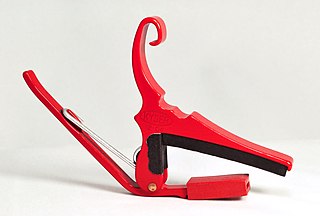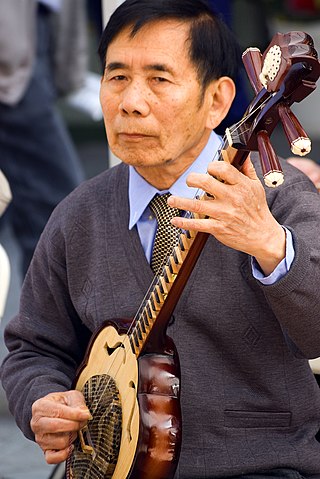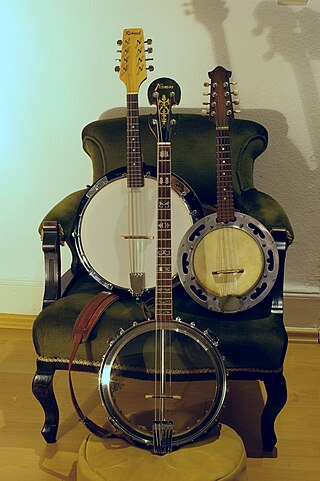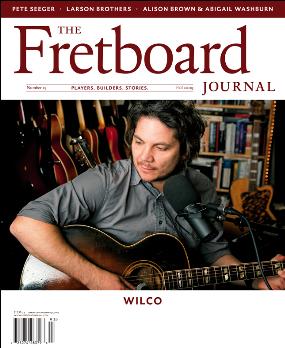The banjo is a stringed instrument with a thin membrane stretched over a frame or cavity to form a resonator. The membrane is typically circular, in modern forms usually made of plastic, originally of animal skin. Early forms of the instrument were fashioned by African Americans and had African antecedents. In the 19th century, interest in the instrument was spread across the United States and United Kingdom by traveling shows of the 19th century minstrel show fad, followed by mass-production and mail-order sales, including instruction method books. The inexpensive or home-made banjo remained part of rural folk culture, but 5-string and 4-string banjos also became popular for home parlour music entertainment, college music clubs, and early 20th century jazz bands. By the early 21st century, the banjo was most frequently associated with folk, bluegrass and country music, but was also used in some rock, pop and even hip-hop music. Among rock bands, the Eagles, Led Zeppelin, and the Grateful Dead have used the five-string banjo in some of their songs.

Lyon & Healy Harps, Inc. is an American musical instrument manufacturer based in Chicago, Illinois and is a subsidiary of Salvi Harps. Today best known for concert harps, the company's Chicago headquarters and manufacturing facility contains a showroom and concert hall. George W. Lyon and Patrick J. Healy began the company in 1864 as a sheet music shop. By the end of the 19th century, they manufactured a wide range of musical instruments—including not only harps, but pianos, guitars, mandolins, banjos, ukuleles and various brass and other percussion instruments.

A capo is a device a musician uses on the neck of a stringed instrument to transpose and shorten the playable length of the strings—hence raising the pitch. It is a common tool for players of guitars, mandolins, mandolas, banjos, ukuleles and bouzoukis. The word derives from the Italian capotasto, which means the nut of a stringed instrument. The earliest known use of capotasto is by Giovanni Battista Doni who, in his Annotazioni of 1640, uses it to describe the nut of a viola da gamba. The first patented capo was designed by James Ashborn of Wolcottville, Connecticut year 1850.
The fingerboard is an important component of most stringed instruments. It is a thin, long strip of material, usually wood, that is laminated to the front of the neck of an instrument. The strings run over the fingerboard, between the nut and bridge. To play the instrument, a musician presses strings down to the fingerboard to change the vibrating length, changing the pitch. This is called stopping the strings. Depending on the instrument and the style of music, the musician may pluck, strum or bow one or more strings with the hand that is not fretting the notes. On some instruments, notes can be sounded by the fretting hand alone, such as with hammer ons, an electric guitar technique.

The cümbüş is a Turkish stringed instrument of relatively modern origin. It was developed in 1930 by Zeynel Abidin Cümbüş (1881–1947) as an oud-like instrument that could be heard as part of a larger ensemble.

A tiple, is a plucked typically 12-string chordophone of the guitar family. A tiple player is called a tiplista. The first mention of the tiple comes from musicologist Pablo Minguet e Irol in 1752. Although many variations of the instrument exist, the tiple is mostly associated with Colombia, and is considered the national instrument. The Puerto Rican version characteristically has fewer strings, as do variants from Cuba, Mallorca, and elsewhere among countries of Hispanic origin.

Shubb is a company that specialises in producing capos for all kinds of stringed instruments. The company was formed in 1974 by banjoists Rick Shubb and Dave Coontz. Shubb capos remain a top-selling capo forty years after their invention. Shubb wanted to create a capo that would not make his instrument go out of tune, which has resulted in ongoing efforts to refine his invention. Since 2016 at least 80% of Shubb's Capos are manufactured in China.
The Weymann Mandolute was one of the products sold under Weymann, the Philadelphia-based brand of Weymann and Sons, established 1864. The 'mandolutes' were actually mandolins with eight strings and tuned exactly the same. The scale length is also within the standard mandolin scale; between 13 inches (330 mm) and 13+7⁄8 inches (350 mm). They advertised using scientific principles to create vibrations, power and volume as well as sustained sweet and mellow tones, all in the same instrument.

The qinqin is a plucked Chinese lute. It was originally manufactured with a wooden body, a slender fretted neck, and three strings.photo 1[ photo 2] Its body can be round,photo hexagonal, or octagonal.[ photo] Often, only two strings were used, as in certain regional silk-and-bamboo ensembles.photo In its hexagonal form, it is also referred to as meihuaqin.

The mandolin-banjo is a hybrid instrument, combining a banjo body with the neck and tuning of a mandolin. It is a soprano banjo. It has been independently invented in more than one country, variously being called mandolin-banjo,banjo-mandolin,banjolin and banjourine in English-speaking countries, banjoline and bandoline in France, and the Cümbüş in Turkey.

A resonator guitar or resophonic guitar is an acoustic guitar that produces sound by conducting string vibrations through the bridge to one or more spun metal cones (resonators), instead of to the guitar's sounding board (top). Resonator guitars were originally designed to be louder than regular acoustic guitars, which were overwhelmed by horns and percussion instruments in dance orchestras. They became prized for their distinctive tone, and found life with bluegrass music and the blues well after electric amplification solved the problem of inadequate volume.

The Regal Musical Instrument Company is a former US musical instruments company and current brand owned by Saga Musical Instruments. Regal was one of the largest manufacturers in the 1930s and became known for a wide range of resonator stringed instruments, including guitars, mandolins, and ukuleles. Only resonator guitars are sold under the Regal brand today, with manufacturing in Korea and distribution in San Francisco, United States.

The Fretboard Journal is a keepsake magazine for guitar, mandolin, and stringed instrument players. In the same vein of other "coffee table magazines" such as The Surfer's Journal, the Golfer's Journal and the Rodder's Journal, it boasts high-end production values, lengthy interviews and exclusive photography in each issue. Each issue is filled with photos of rare instruments, well-known musicians, and even the workshops of instrument builders. The magazine is also distributed digitally.

Banjo guitar or banjitar or ganjo (Australia) is a six-string banjo tuned in the standard tuning of a six-string guitar. It differs from the standard five-string banjo, which features a short drone string that ends three-quarters of the way up the neck an the low side of the fretboard but is tuned highest of the strings in re-entrant tuning. The first versions of six-string banjos were introduced in the late 19th century though did not gain popularity. The concept was reintroduced in the latter part of the 20th century with modern guitar-like tuning, allowing guitarists to play with a banjo sound without having to learn all new fingerings.
Richard Shubb is best known as the inventor of the Shubb Capo, a very popular guitar and banjo accessory. His 1978 patent is cited by Sterner's Capo Museum as being one of the most significant improvements in the development of the capo. He also invented the lever-operated banjo fifth string capo, the compensated banjo bridge, and holds several other U.S. and international patents on musical instrument accessories and improvements.

Elderly Instruments is a musical instrument retailer in Lansing, Michigan, United States, with a reputation as a "megastore", a repair shop and a locus for folk music including bluegrass and "twang". Specializing in fretted instruments, including acoustic and electric guitars, banjos, mandolins, and ukuleles, Elderly maintains a selection of odd or rare instruments. Elderly is known as a premier repair shop for fretted instruments, as one of the larger vintage instrument dealers in the United States, and as a major dealer of Martin guitars in particular.

John H. Lee was the stage name for John D. Haley, an American banjoist, composer and author of the late 19th century. He was known as a harmonist, writing lessons for playing harmony on the five-string banjo and employing "remarkeable fingering" to construct chords. He promoted three new types of banjo for S. S. Stewart, the banjeaurine, Little Wonder picolo banjo, and six-string banjo, performing on the instruments alongside William A. Huntley.

Oscar Schmidt was a musical instrument manufacturing company established in 1871. During its long existence, Oscar Schmidt has produced a wide range of string instruments, not only guitars but also numerous models of parlour instruments such as autoharps, celtic harps, guitar zithers, the "guitarophone", marxophones and bowed psalterys.

Collings Guitars is an Austin, Texas based stringed instrument manufacturer. The company was founded in 1973 by BillCollings. In addition to acoustic guitars, Collings Guitars manufactures: electric guitars, archtop guitars, mandolins and ukuleles.

Blackbird Guitars is a musical instrument company that manufactures acoustic guitars and ukuleles from composite materials, including carbon fiber and ekoa, a flax linen reinforcement fabric in a bio-epoxy matrix. The company has made contributions to both the field of luthiery and the field of composite design, notably with the composite all-hollow unibody instrument design used on all Blackbird models, as well as the development and use of Ekoa in the construction of fretted instruments.

















